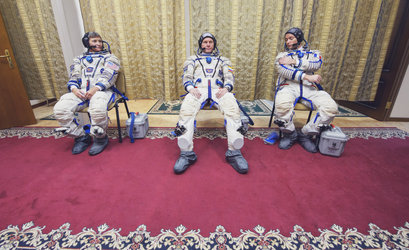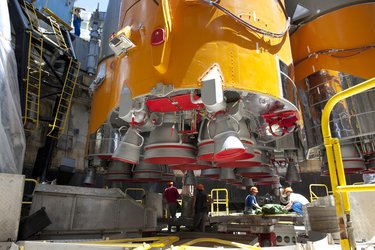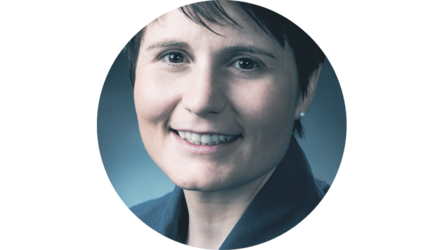Accept all cookies Accept only essential cookies See our Cookie Notice

About ESA
The European Space Agency (ESA) is Europe’s gateway to space. Its mission is to shape the development of Europe’s space capability and ensure that investment in space continues to deliver benefits to the citizens of Europe and the world.
Highlights
ESA - United space in Europe
This is ESA ESA facts Member States & Cooperating States Funding Director General Top management For Member State Delegations European vision European Space Policy ESA & EU Space Councils Responsibility & Sustainability Annual Report Calendar of meetings Corporate newsEstablishments & sites
ESA Headquarters ESA ESTEC ESA ESOC ESA ESRIN ESA EAC ESA ESAC Europe's Spaceport ESA ESEC ESA ECSAT Brussels Office Washington OfficeWorking with ESA
Business with ESA ESA Commercialisation Gateway Law at ESA Careers Cyber resilience at ESA IT at ESA Newsroom Partnerships Merchandising Licence Education Open Space Innovation Platform Integrity and Reporting Administrative Tribunal Health and SafetyMore about ESA
History ESA Historical Archives Exhibitions Publications Art & Culture ESA Merchandise Kids Diversity ESA Brand CentreLatest
Space in Member States
Find out more about space activities in our 23 Member States, and understand how ESA works together with their national agencies, institutions and organisations.
Science & Exploration
Exploring our Solar System and unlocking the secrets of the Universe
Go to topicAstronauts
Missions
Juice Euclid Webb Solar Orbiter BepiColombo Gaia ExoMars Cheops Exoplanet missions More missionsActivities
International Space Station Orion service module Gateway Concordia Caves & Pangaea BenefitsLatest
Space Safety
Protecting life and infrastructure on Earth and in orbit
Go to topicAsteroids
Asteroids and Planetary Defence Asteroid danger explained Flyeye telescope: asteroid detection Hera mission: asteroid deflection Near-Earth Object Coordination CentreSpace junk
About space debris Space debris by the numbers Space Environment Report In space refuelling, refurbishing and removingSafety from space
Clean Space ecodesign Zero Debris Technologies Space for Earth Supporting Sustainable DevelopmentLatest
Applications
Using space to benefit citizens and meet future challenges on Earth
Go to topicObserving the Earth
Observing the Earth Future EO Copernicus Meteorology Space for our climate Satellite missionsCommercialisation
ESA Commercialisation Gateway Open Space Innovation Platform Business Incubation ESA Space SolutionsLatest
Enabling & Support
Making space accessible and developing the technologies for the future
Go to topicBuilding missions
Space Engineering and Technology Test centre Laboratories Concurrent Design Facility Preparing for the future Shaping the Future Discovery and Preparation Advanced Concepts TeamSpace transportation
Space Transportation Ariane Vega Space Rider Future space transportation Boost! Europe's Spaceport Launches from Europe's Spaceport from 2012Latest

The type of sensor that caused the malfunction during launch
Thank you for liking
You have already liked this page, you can only like it once!
ESA astronaut Alexander Gerst, NASA astronaut Serena Auñón-Chancellor and Roscosmos cosmonaut Sergei Prokopyev will welcome new arrivals to the International Space Station on 3 December: Canadian Space Agency astronaut David Saint-Jacques, NASA astronaut Anne McClain and Roscosmos cosmonaut Oleg Kononenko will arrive at the orbital outpost as part of Expeditions 58/59, increasing the population of humans in space to six.
This announcement comes after a thorough investigation of the Soyuz MS-10 that aborted its launch on 11 October, when a malfunction forced cosmonaut Alexey Ovchinin of Roscosmos and NASA astronaut Nick Hague to return to Earth just moments after liftoff.
A State Commission launched by Roscosmos confirmed that a damaged separation sensor caused the launch abort during a press conference held today.
According to the launch sequence of the Soyuz rocket, around two minutes into the flight the booster should detach from its mounting. A sensor activates a valve that ejects gas to push away the top of the booster.
Three upcoming Soyuz rocket launches will be closely monitored this month to reassure that the sensors are correctly integrated. The sensors on the launchers of the Progress MS-10 cargo launch and the next manned Soyuz MS-11 launching on 3 December will be checked and reassembled.
Since the sensor did not work, one of the boosters was not pushed away but instead slipped down and damaged the rocket’s second stage. The investigative commission stated that the “launch concluded with a failure of the launch vehicle due to abnormal separation of one of the side boosters, whose nose section hit the core stage in the area of the fuel tank, which led to its depressurisation and the loss of stability of the launch vehicle.”
The image below shows the sensor, a metallic ball resembling a push button. This sensor was bent by 6° due to a mistake during the assembly of the launch vehicle at Baikonur, Russia’s cosmodrome in Kazakhstan.
The commission identified the root cause by analysing data and video footage, together with mathematical simulations.
-
CREDIT
Roscosmos -
LICENCE
ESA Standard Licence

Expedition 57 crew return to Baikonur after an abort…

Waiting for exams

Soyuz: launch to orbit – complete astronaut launch i…

Rockin' rocket















 Germany
Germany
 Austria
Austria
 Belgium
Belgium
 Denmark
Denmark
 Spain
Spain
 Estonia
Estonia
 Finland
Finland
 France
France
 Greece
Greece
 Hungary
Hungary
 Ireland
Ireland
 Italy
Italy
 Luxembourg
Luxembourg
 Norway
Norway
 The Netherlands
The Netherlands
 Poland
Poland
 Portugal
Portugal
 Czechia
Czechia
 Romania
Romania
 United Kingdom
United Kingdom
 Slovenia
Slovenia
 Sweden
Sweden
 Switzerland
Switzerland






















